By Angela Tillapaugh – Library Assistant
As the cold winter months are rapidly approaching, I have found myself with the desire to knit all things warm and cozy. And luckily there is a booklet in the collections of the MHS to assist me on this endeavor. “Comforts for the Men” was published in 1917 by Columbia Yarns and provided patterns for garments suggested by the American Red Cross and the British Relief Committee. The booklet gives instructions for the garments, and of course, suggestions for which Columbia brand needles and yarn you should purchase to knit them.
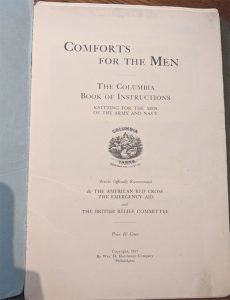
This type of booklet was common during World War I. There was a large demand for socks and other knitted items for soldiers overseas, leading the American Red Cross to publish patterns for garments and encourage citizens to “knit their bit”. The Red Cross provided knitting materials as well, so long as leftover yarn was returned to prevent any wool from being wasted.[i] Yarn companies used this as a chance to advertise their own products and published their own books with patterns for similar garments. Knitting became a popular pastime in the United States, many people hosted knitting parties and clubs for their communities. The popularity of knitting likely emerged because it gave Americans a hobby that contributed to the war effort and connected them with others affected by the ongoing war.
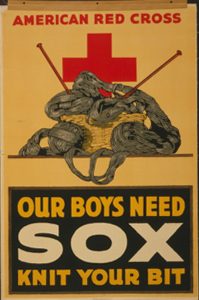
Because I had to knit this without any concrete information on gauge, final sizing, or yarn, I decided it would be best to pick something simple. While I always enjoy a knitting challenge, considering the lack of information on materials and the vague directions, I was positive any attempt would yield disastrous results. I decided to try out the knitted wristlets. These wristlets are a ribbed rectangle sewn up the side with some space left for the wearer’s thumb.
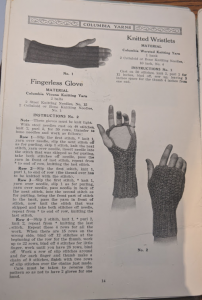
The directions for the wristlets call for a No. 4 celloid or bone knitting needle and Columbia Worsted Knitting Yarn. The material that the needle is made of is important because the diameter of bone and plastic needles used to increase as the number increased, while steel needles got smaller as the number increased. I checked a few different resources about old knitting needle sizing, and most agreed that a No. 4 knitting celloid or bone needle would equal about a US 4 today. The name of the yarn suggested that it is a worsted weight. I decided to use some leftover worsted weight wool yarn from a previous garment I made. I thought it would be fitting to use up some scrap yarns for this project, using up every bit of good wool was of the utmost importance during the wartime years.
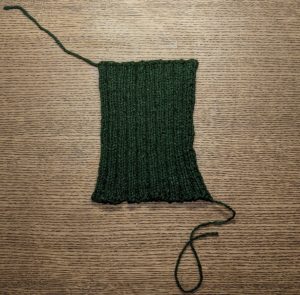
As per the instructions, I cast on 50 stitches. After knitting a few rows, I realized that these were going to end up far too wide for my hands. These wristlets were probably designed for someone with larger hands, but even with that in mind they seemed pretty big. It is possible they were ending up wide because of the thickness of the yarn I was using; the suggested yarn in the original pattern may have been lighter than modern than worsted weight yarn. This would make sense because a US 4 needle for worsted weight yarn is a smaller needle size than what most modern patterns would suggest. I tried again and reduced the stitch count to 40, and they ended up fitting really well. I worked on these over about three days but it only took a few hours all together to make. While these wristlets are not perfectly accurate to the pattern considering the materials and changes I made, I learned a lot making them. Also I think amateur knitters like me would have put their own creative spins on these patterns back in 1917 as well. I think this is a great project for any knitter looking to add a bit of historical inspiration into your crafting, and I highly recommend trying out old patterns and seeing what comes of it.
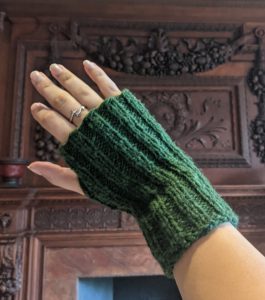
[i] Lovick, E., Brodnicki, J., Loven, P., & Doyle, E. (2014). Knitting in WW1. In Centenary stitches: Telling the story of one WW1 family through vintage knitting and crochet (pp. 9-11). Orkney, Scotland: Northern Lace Press.


Angela, what fun to read this article! As the co-coordinator of the Morse Institute Library Stitchers (Natick, MA), we receive a lot of donated yarn sans labels and we’re always having to figure out the fiber, weight, and yardage. The worst donation we received was a lot of what we thought was lovely brown wool—then we discovered that it had been invested with moths: the yarn kept breaking in short lengths. One of the group took it home to put in her compost pile! The pandemic has certainly affected our stitching. We do hold our monthly meeting over Zoom; yes, about 24 women knitting and crocheting as they chat. We have completed 450 hats for the HatNotHate project (given to Natick 7th graders), a Climestry (climate tapestry) showing the temperature changes from 1900 to 2020, and a special blanket for a local couple injured in an horrific accident in town. Can’t keep the Stitchers down, although we cannot access our library stash of yarn. We’re busy now stitching holiday items for a local charity.